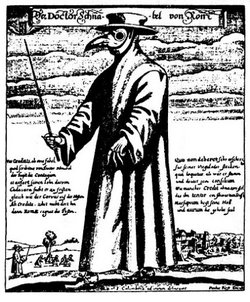The bubonic plague, often called 'Black Death' after its most famous outbreak in the 14th century, still exists today and, like then, is caused by bacteria called Yersinia pestis that are found mainly in rodents and the fleas that feed on them. When other animals or humans contract this bacteria it is primarily from those infected rodent or flea bites.
Bubonic plague affects the lymph nodes resulting in swollen lymph glands (called buboes, thus the name bubonic), fever, chills and flu-like symptoms but in addition tiny broken blood vessels called petechiae can result in black spots on the skin and those black spots earned it the nickname that stuck when it reached England in 1348 AD.

The Black Death wasn't the first bubonic plague - there was a Justinian plague in 558 AD and even that's just the only one we know about - and after that the 14th century it resurged in the 17th and 18th centuries. In the 1880s it killed as many as 12 million people in China. 10-20 cases happen in the US each year even now.
But the Black Death is the big one, killing as much as one third of Europe. How do we know? Well, we don't know for sure. Mortality estimates were 75% but only churches kept any kind of consistent records and one third of the clergy in England perished so that is a reasonable metric for Europe as a whole. It started, they say, in the lower Volga at Sarai, the capital of the Khanates of The Golden Horde and once it reached Genoese trading stations it spread by boat. It was, by all accounts a catastrophic event for the population of Europe.
How can I contend that a disaster for millions of people resulted in European dominance for the rest of that millenium? Proving old claims are what anthropology and science are all about. People used to think all mold was a bad thing too.
In a bullion economy with fewer people, poor people get rich and technology is necessary
This is not the place to learn all about the Black Death from an epidemiology perspective but we are going to discuss its societal impact. Europe became the standard bearer for culture, discovery and technology for the next few hundred years because of the necessity of optimization that all those deaths brought.
While it was officially over in 1353 the plague actually hung around until after 1400, cyclically wiping out huge chunks of population, keeping the population static and forcing Europeans to succeed in new ways.

In 1353, just after the Black Death and its population catastrophe, little would seem to have changed. Europe was still at war every few years and wages did not move despite the loss of labor but, over a few decades and with one-third of the population remaining gone, real wages for ordinary farm workers, who had been forced into serfdom previously, shot up by 50%. More bullion among a smaller population meant more wealth across all classes and because the same land was in use and it was now plentiful, it resulted in technological advances as well. The Black Death, it can be argued, is the grandfather of the Technical Revolution that resulted in miniaturization and even the printing press in 1454. The Chinese first made paper but Europeans made paper great.(2)
The Near East was not devastated and continued to rely on geographical luck. As a result they remained static and even slipped a little, relying on the Spice Route without the need for innovation that forced Europe to create the three-masted ship and improved mining technology to resurrect depleted silver mines.
But the three-masted ship, and the Age Of Exploration it would lead to, would come later. What really made Europe great were inventions like the heavy plow and those resulted from a European need to be more flexible, more innovative and more knowledgeable than contemporary extra-European societies.(3)
The plow had been in existence since the late Roman period and had made improvements but the optimization that resulted from the plague made agriculture, the engine of Europe (and culturally they must believe this is still important to them today, since 85% of the world total in agriculture subsidies are on European products) incredibly efficient. Forced by population loss into greater knowledge and more flexibility, they maintained that attitude when the population curve started to go up again, so they became much richer than other cultures.
With more wealth came greater literacy. This makes sense. Flexibility and technological improvements do not happen in illiterate societies, they happen in societies where education brings the realization that some answers are better than others.
In 1348 the literacy rate for Europe and the Near East was under 5% but by 1800 it was over 50% in Europe. In Turkey during that time the literacy rate remained at 5% - they didn't even get a printing press until 1726.(4)
This accounts for how Europe, with only 73 million people a few decades after the plague, could eventually 'colonize' India (110 million at that time) and China (120 million) and create a New World empire some hundred plus years later.
So, in wrapping up, the technological advances that led to wealth advances that led to literacy and eventually worldwide domination by European countries can be traced back to a devastating event - the Black Death - because the reduced population led to agricultural advancements in both management and efficiency; the three field system was an improvement over two but the discovery that a properly shod and harnessed horse was better than an ox and more intensive exploitation of the land resulted in a huge improvement in living standards for most people.
The Black Death and resulting wealth across the population allowed for new opportunities for many workers who would have been just Serfs previously. It created what we now call a Middle Class.
From Boccaccio's "The Decameron":
I say, then, that the years of the beatific incarnation of the Son of God had reached the tale of one thousand three hundred and forty-eight when in the illustrious city of Florence, the fairest of all the cities of Italy, there made its appearance that deadly pestilence, which, whether disseminated by the influence of the celestial bodies, or sent upon us mortals by God in His just wrath by way of retribution for our iniquities,had had its origin some years before in the East, whence, after destroying an innumerable multitude of living beings, it had propagated itself without respite from place to place, and so, calamitously, had spread into the West.
NOTES:
(1) Put quite famously in modern times by Muhammad Ali after he traveled to Zaire to fight George Foreman and reporters asked him what he thought of Africa: "Thank God my granddaddy got on that boat."
(2) And that isn't the only instance where Europeans took Chinese inventions and, spurred by the need for optimization, used them to become the world standard - the crossbow, the compass and gunpowder can't escape without a mention.
(3) The Japanese between 1868-89 are another example, more modern and even more rapid, and have remained that way since despite little in the way of strategic resources and a small population.
(4) It closed down between 1730-1780 and again in 1800. There was simply no interest, reflected in Europe's 10,000:1 ratio of printed books.
REFERENCES:
Bahmanyar M, Cavanaugh DC. Plague Manual. Geneva: World Health Organization, 1976.
McEvedy C. The New Penguin Atlast of Medieval History. Penguin (Non-Classics) (April 30, 1968) ISBN-10: 0140708227





Comments